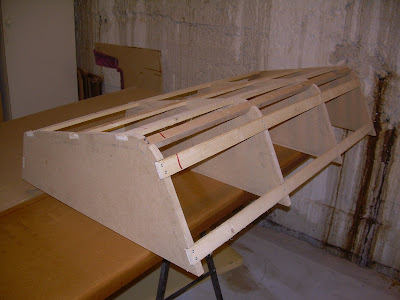
Anchor locker being roughly cut to size. I expect this is easier achieved before hull join.

Planking the main cabin deck.

Detailed study of unsuccessful infusion of daggerboard case with gel coat.

This blog was created to share experiences from my building of the Ian Farrier designed trimaran F-22R with other builders interested, and to anyone else that might have an interest in why anyone willingly spends hundreds of hours in a room without windows to build a weird looking boat that will sail circles around the traditional sailing boats in this part of the world
















 I think all panels are ready now, except three that I still have to make; aft cabin bunktop, daggerboard support web and bow bulkhead.
I think all panels are ready now, except three that I still have to make; aft cabin bunktop, daggerboard support web and bow bulkhead. Working on the form frames for the anchor locker.
Working on the form frames for the anchor locker.

